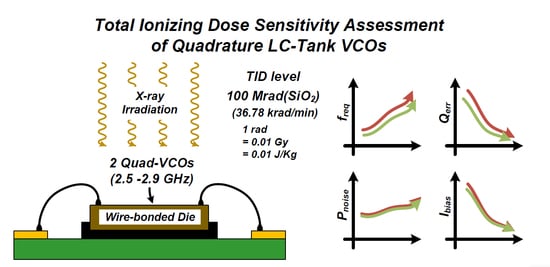TID Sensitivity Assessment of Quadrature LC-Tank VCOs Implemented in 65-nm CMOS Technology
Abstract
:1. Introduction
2. Implementation
3. Experimental Results
4. Conclusions
Author Contributions
Funding
Institutional Review Board Statement
Informed Consent Statement
Data Availability Statement
Conflicts of Interest
References
- Musa, A.; Murakami, R.; Sato, T.; Chaivipas, W.; Okada, K.; Matsuzawa, A. A Low Phase Noise Quadrature Injection Locked Frequency Synthesizer for MM-Wave Applications. IEEE J. Solid-State Circuits 2011, 46, 2635–2649. [Google Scholar] [CrossRef]
- Chamas, I.R.; Raman, S. Analysis and Design of a CMOS Phase-Tunable Injection-Coupled LC Quadrature VCO (PTIC-QVCO). IEEE J. Solid-State Circuits 2009, 44, 784–796. [Google Scholar] [CrossRef]
- Eroglu, A. Non-Invasive Quadrature Modulator Balancing Method to Optimize Image Band Rejection. IEEE Trans. Circuits Syst. I Regul. Pap. 2014, 61, 600–612. [Google Scholar] [CrossRef]
- Nikoofard, A.; Kananian, S.; Fotowat-Ahmady, A. A fully analog calibration technique for phase and gain mismatches in image-reject receivers. AEU-Int. J. Electron. Commun. 2015, 69, 823–835. [Google Scholar] [CrossRef]
- Lee, J.; Razavi, B. A 40-Gb/s clock and data recovery circuit in 0.18-μm CMOS technology. IEEE J. Solid-State Circuits 2003, 38, 2181–2190. [Google Scholar] [CrossRef]
- Mazzanti, A.; Svelto, F.; Andreani, P. On the amplitude and phase errors of quadrature LC-tank CMOS oscillators. IEEE J. Solid-State Circuits 2006, 41, 1305–1313. [Google Scholar] [CrossRef]
- Natarajan, A.; Komijani, A.; Guan, X.; Babakhani, A.; Hajimiri, A. A 77-GHz Phased-Array Transceiver with On-Chip Antennas in Silicon: Transmitter and Local LO-Path Phase Shifting. IEEE J. Solid-State Circuits 2006, 41, 2807–2819. [Google Scholar] [CrossRef] [Green Version]
- Scheir, K.; Bronckers, S.; Borremans, J.; Wambacq, P.; Rolain, Y. A 52 GHz Phased-Array Receiver Front-End in 90 nm Digital CMOS. IEEE J. Solid-State Circuits 2008, 43, 2651–2659. [Google Scholar] [CrossRef]
- Nikoofard, A.; Kananian, S.; Fotowat-Ahmady, A. Off-Resonance Oscillation, Phase Retention, and Orthogonality Modeling in Quadrature Oscillators. IEEE Trans. Circuits Syst. I Regul. Pap. 2016, 63, 883–894. [Google Scholar] [CrossRef]
- Zhang, L.; Kuo, N.C.; Niknejad, A.M. A 37.5–45 GHz Superharmonic-Coupled QVCO with Tunable Phase Accuracy in 28 nm CMOS. IEEE J. Solid-State Circuits 2019, 54, 2754–2764. [Google Scholar] [CrossRef]
- Oliveira, L.B.; Fernandes, J.R.; Filanovsky, I.M.; Verhoeven, C.J.; Silva, M.M. Analysis and Design of Quadrature Oscillators; Springer Science & Business Media: Berlin/Heidelberg, Germany, 2008. [Google Scholar]
- Koo, J.; Kim, B.; Park, H.J.; Sim, J.Y. A Quadrature RC Oscillator with Noise Reduction by Voltage Swing Control. IEEE Trans. Circuits Syst. I Regul. Pap. 2019, 66, 3077–3088. [Google Scholar] [CrossRef]
- Dai, L.; Harjani, R. A low-phase-noise CMOS ring oscillator with differential control and quadrature outputs. In Proceedings of the 14th Annual IEEE International ASIC/SOC Conference (IEEE Cat. No.01TH8558), Arlington, VA, USA, 12–15 September 2001; pp. 134–138. [Google Scholar] [CrossRef]
- Pankratz, E.J.; Sanchez-Sinencio, E. Multiloop High-Power-Supply-Rejection Quadrature Ring Oscillator. IEEE J. Solid-State Circuits 2012, 47, 2033–2048. [Google Scholar] [CrossRef]
- Behbahani, F.; Kishigami, Y.; Leete, J.; Abidi, A. CMOS mixers and polyphase filters for large image rejection. IEEE J. Solid-State Circuits 2001, 36, 873–887. [Google Scholar] [CrossRef] [Green Version]
- Sah, S.P.; Yu, X.; Heo, D. Design and Analysis of a Wideband 15–35-GHz Quadrature Phase Shifter with Inductive Loading. IEEE Trans. Microw. Theory Tech. 2013, 61, 3024–3033. [Google Scholar] [CrossRef]
- Lee, T.H. The Design of CMOS Radio-Frequency Integrated Circuits; Cambridge University Press: Cambridge, UK, 2003. [Google Scholar]
- Andreani, P.; Bonfanti, A.; Romano, L.; Samori, C. Analysis and design of a 1.8-GHz CMOS LC quadrature VCO. IEEE J. Solid-State Circuits 2002, 37, 1737–1747. [Google Scholar] [CrossRef]
- Chang, H.Y.; Chiu, Y.T. K-Band CMOS Differential and Quadrature Voltage-Controlled Oscillators for Low Phase-Noise and Low-Power Applications. IEEE Trans. Microw. Theory Tech. 2012, 60, 46–59. [Google Scholar] [CrossRef]
- Chang, H.Y.; Lin, C.H.; Liu, Y.C.; Yeh, Y.L.; Chen, K.; Wu, S.H. 65-nm CMOS Dual-Gate Device for Ka-Band Broadband Low-Noise Amplifier and High-Accuracy Quadrature Voltage-Controlled Oscillator. IEEE Trans. Microw. Theory Tech. 2013, 61, 2402–2413. [Google Scholar] [CrossRef]
- Decanis, U.; Ghilioni, A.; Monaco, E.; Mazzanti, A.; Svelto, F. A Low-Noise Quadrature VCO Based on Magnetically Coupled Resonators and a Wideband Frequency Divider at Millimeter Waves. IEEE J. Solid-State Circuits 2011, 46, 2943–2955. [Google Scholar] [CrossRef]
- Kuo, N.C.; Chien, J.C.; Niknejad, A.M. Design and Analysis on Bidirectionally and Passively Coupled QVCO with Nonlinear Coupler. IEEE Trans. Microw. Theory Tech. 2015, 63, 1130–1141. [Google Scholar] [CrossRef]
- Karmakar, A.; Wang, J.; Prinzie, J.; De Smedt, V.; Leroux, P. A Review of Semiconductor Based Ionising Radiation Sensors Used in Harsh Radiation Environments and Their Applications. Radiation 2021, 1, 194–217. [Google Scholar] [CrossRef]
- Faccio, F.; Michelis, S.; Cornale, D.; Paccagnella, A.; Gerardin, S. Radiation-Induced Short Channel (RISCE) and Narrow Channel (RINCE) Effects in 65 and 130 nm MOSFETs. IEEE Trans. Nucl. Sci. 2015, 62, 2933–2940. [Google Scholar] [CrossRef]
- Borghello, G. Ionizing Radiation Effects in Nanoscale CMOS Technologies Exposed to Ultra-High Doses. Ph.D. Thesis, University of Udine, Udine, Italy, 2019. [Google Scholar]
- Borghello, G.; Lerario, E.; Faccio, F.; Koch, H.; Termo, G.; Michelis, S.; Marquez, F.; Palomo, F.; Muñoz, F. Ionizing radiation damage in 65 nm CMOS technology: Influence of geometry, bias and temperature at ultra-high doses. Microelectron. Reliab. 2021, 116, 114016. [Google Scholar] [CrossRef]
- Wang, T.; Wang, K.; Chen, L.; Dinh, A.; Bhuva, B.; Shuler, R. A RHBD LC-Tank Oscillator Design Tolerant to Single-Event Transients. IEEE Trans. Nucl. Sci. 2010, 57, 3620–3625. [Google Scholar] [CrossRef]
- Prinzie, J.; Christiansen, J.; Moreira, P.; Steyaert, M.; Leroux, P. Comparison of a 65 nm CMOS Ring- and LC-Oscillator Based PLL in Terms of TID and SEU Sensitivity. IEEE Trans. Nucl. Sci. 2017, 64, 245–252. [Google Scholar] [CrossRef]
- Monda, D.; Ciarpi, G.; Saponara, S. Design and Verification of a 6.25 GHz LC-Tank VCO Integrated in 65 nm CMOS Technology Operating up to 1 Grad TID. IEEE Trans. Nucl. Sci. 2021, 68, 2524–2532. [Google Scholar] [CrossRef]
- Jagtap, S.; Sharma, D.; Gupta, S. Design of SET tolerant LC oscillators using distributed bias circuitry. Microelectron. Reliab. 2015, 55, 1537–1541. [Google Scholar] [CrossRef]
- Karthigeyan, A.; Radha, S.; Manikandan, E. Single event transient mitigation techniques for a cross-coupled LC oscillator, including a single-event transient hardened CMOS LC-VCO circuit. IET Circuits Devices Syst. 2022, 16, 178–188. [Google Scholar] [CrossRef]
- Jagtap, S.; Anmadwar, S.; Rudrapati, S.; Gupta, S. A Single-Event Transient-Tolerant High-Frequency CMOS Quadrature Phase Oscillator. IEEE Trans. Nucl. Sci. 2019, 66, 2072–2079. [Google Scholar] [CrossRef]
- Loveless, T.D.; Jagannathan, S.; Zhang, E.X.; Fleetwood, D.M.; Kauppila, J.S.; Haeffner, T.D.; Massengill, L.W. Combined Effects of Total Ionizing Dose and Temperature on a K-Band Quadrature LC-Tank VCO in a 32 nm CMOS SOI Technology. IEEE Trans. Nucl. Sci. 2017, 64, 204–211. [Google Scholar] [CrossRef]
- Chamas, I.R.; Raman, S. A Comprehensive Analysis of Quadrature Signal Synthesis in Cross-Coupled RF VCOs. IEEE Trans. Circuits Syst. I Regul. Pap. 2007, 54, 689–704. [Google Scholar] [CrossRef]
- Mirzaei, A.; Heidari, M.E.; Bagheri, R.; Chehrazi, S.; Abidi, A.A. The Quadrature LC Oscillator: A Complete Portrait Based on Injection Locking. IEEE J. Solid-State Circuits 2007, 42, 1916–1932. [Google Scholar] [CrossRef]
- Prinzie, J.; Christiansen, J.; Moreira, P.; Steyaert, M.; Leroux, P. A 2.56-GHz SEU Radiation Hard LC-Tank VCO for High-Speed Communication Links in 65-nm CMOS Technology. IEEE Trans. Nucl. Sci. 2018, 65, 407–412. [Google Scholar] [CrossRef]
- Menouni, M.; Barbero, M.; Bompard, F.; Bonacini, S.; Fougeron, D.; Gaglione, R.; Rozanov, A.; Valerio, P.; Wang, A. 1-Grad total dose evaluation of 65 nm CMOS technology for the HL-LHC upgrades. J. Instrum. 2015, 10, C05009. [Google Scholar] [CrossRef] [Green Version]
- Tong, H.; Cheng, S.; Lo, Y.C.; Karsilayan, A.I.; Silva-Martinez, J. An LC Quadrature VCO Using Capacitive Source Degeneration Coupling to Eliminate Bi-Modal Oscillation. IEEE Trans. Circuits Syst. I Regul. Pap. 2012, 59, 1871–1879. [Google Scholar] [CrossRef]
- Gierkink, S.; Levantino, S.; Frye, R.; Samori, C.; Boccuzzi, V. A low-phase-noise 5-GHz CMOS quadrature VCO using superharmonic coupling. IEEE J. Solid-State Circuits 2003, 38, 1148–1154. [Google Scholar] [CrossRef]
- Hegazi, E.; Sjoland, H.; Abidi, A. A filtering technique to lower LC oscillator phase noise. IEEE J. Solid-State Circuits 2001, 36, 1921–1930. [Google Scholar] [CrossRef] [Green Version]
- Wu, T.; Moon, U.K.; Mayaram, K. Dependence of LC VCO oscillation frequency on bias current. In Proceedings of the 2006 IEEE International Symposium on Circuits and Systems (ISCAS), Island of Kos, Greece, 21–24 May 2006; p. 4. [Google Scholar] [CrossRef] [Green Version]
- Heiman, F.; Warfield, G. The effects of oxide traps on the MOS capacitance. IEEE Trans. Electron Devices 1965, 12, 167–178. [Google Scholar] [CrossRef] [Green Version]
- Fernández-Martínez, P.; Cortés, I.; Hidalgo, S.; Flores, D.; Palomo, F.R. Simulation of Total Ionising Dose in MOS capacitors. In Proceedings of the 8th Spanish Conference on Electron Devices, CDE’2011, Palma de Mallorca, Spain, 8–11 February 2011; pp. 1–4. [Google Scholar] [CrossRef]
- Rael, J.; Abidi, A.A. Physical processes of phase noise in differential LC oscillators. In Proceedings of the IEEE 2000 Custom Integrated Circuits Conference (Cat. No. 00CH37044), Orlando, FL, USA, 24 May 2000; pp. 569–572. [Google Scholar]
- Re, V.; Gaioni, L.; Manghisoni, M.; Ratti, L.; Traversi, G. Comprehensive Study of Total Ionizing Dose Damage Mechanisms and Their Effects on Noise Sources in a 90 nm CMOS Technology. IEEE Trans. Nucl. Sci. 2008, 55, 3272–3279. [Google Scholar] [CrossRef]
- Mazza, G.; Panati, S. A Compact, Low Jitter, CMOS 65 nm 4.8–6 GHz Phase-Locked Loop for Applications in HEP Experiments Front-End Electronics. IEEE Trans. Nucl. Sci. 2018, 65, 1212–1217. [Google Scholar] [CrossRef]
- Biereigel, S.; Kulis, S.; Leitao, P.; Francisco, R.; Moreira, P.; Leroux, P.; Prinzie, J. A low noise fault tolerant radiation hardened 2.56 Gbps clock-data recovery circuit with high speed feed forward correction in 65 nm CMOS. IEEE Trans. Circuits Syst. I Regul. Pap. 2019, 67, 1438–1446. [Google Scholar] [CrossRef]


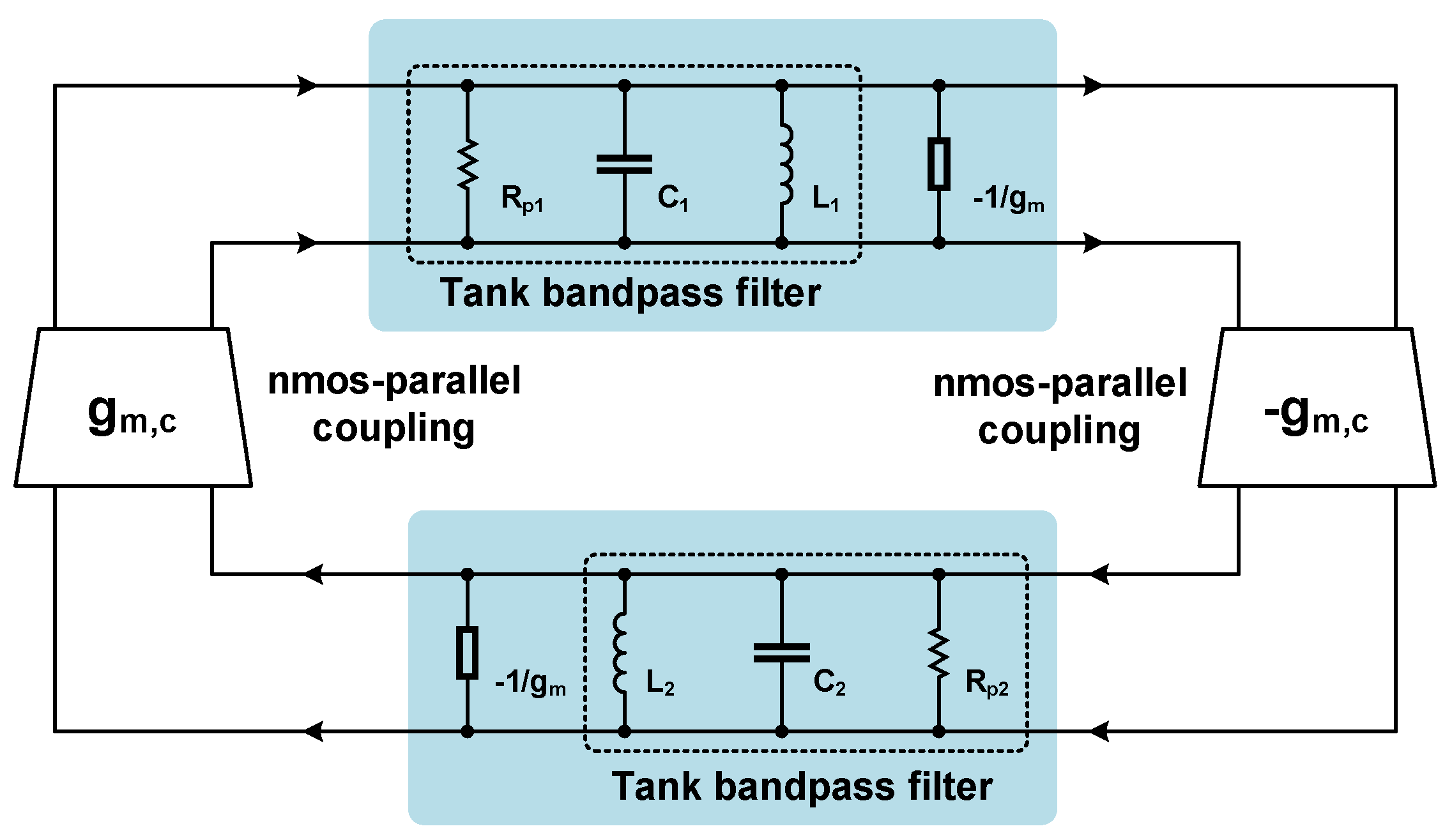
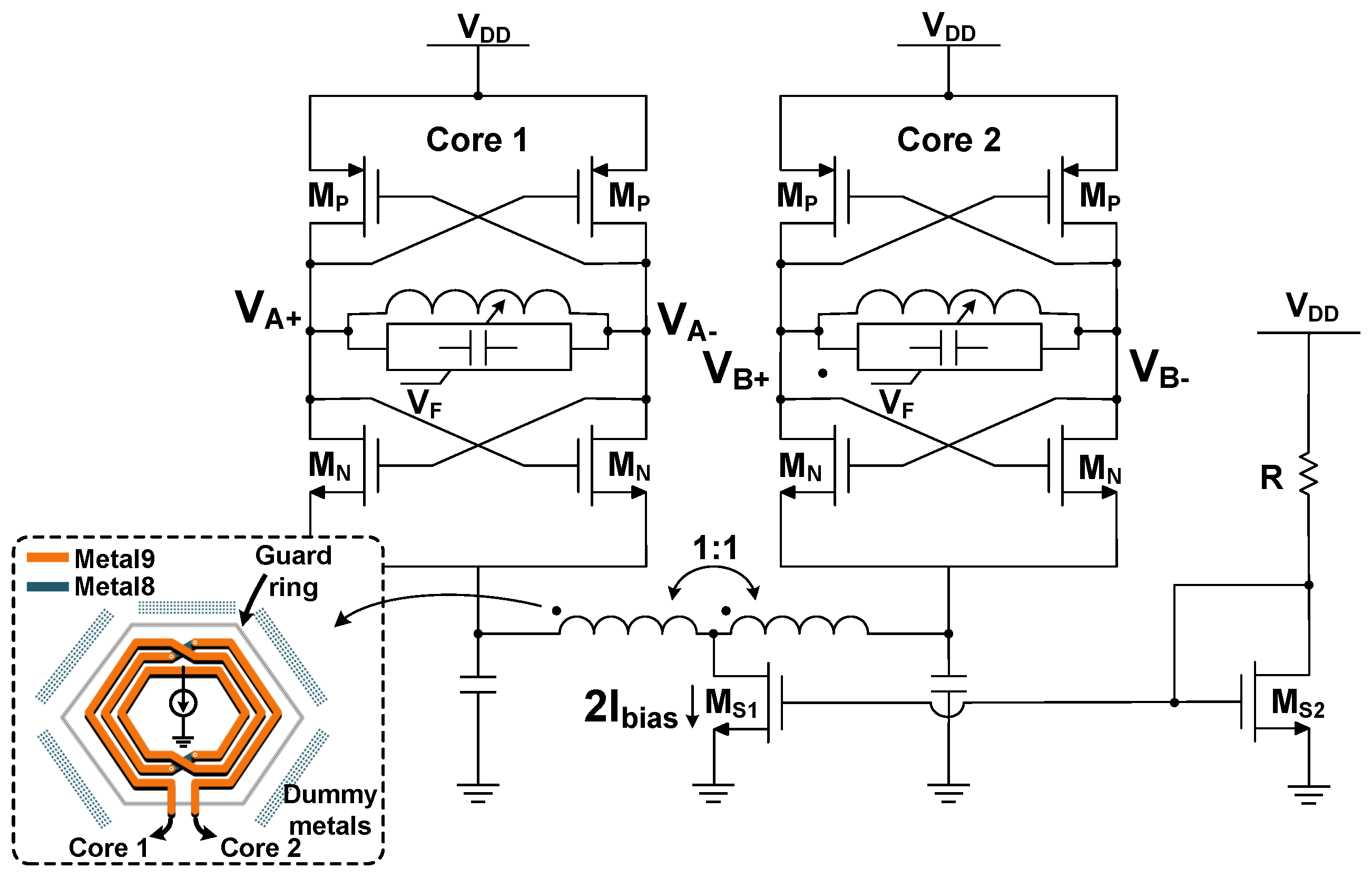
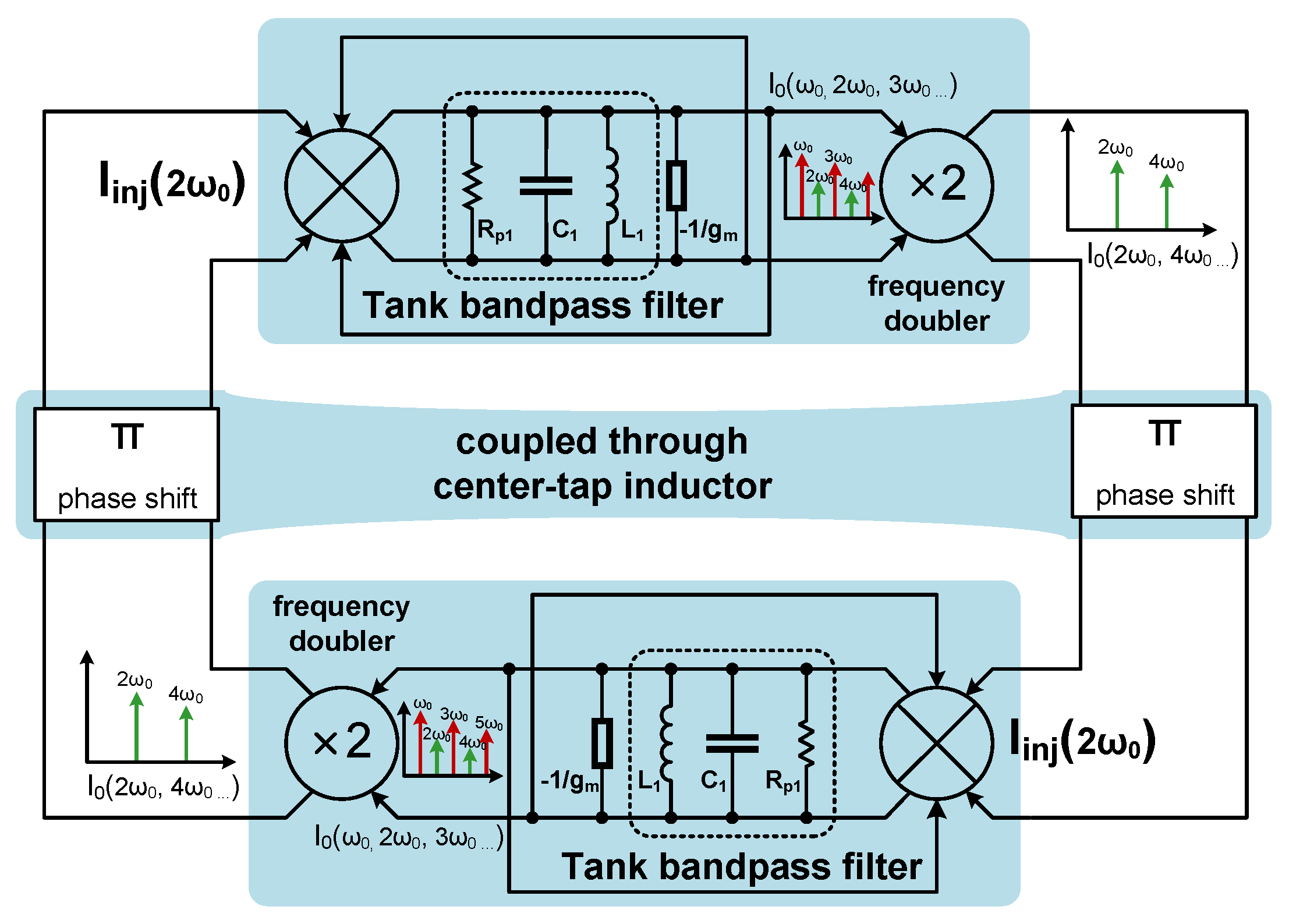


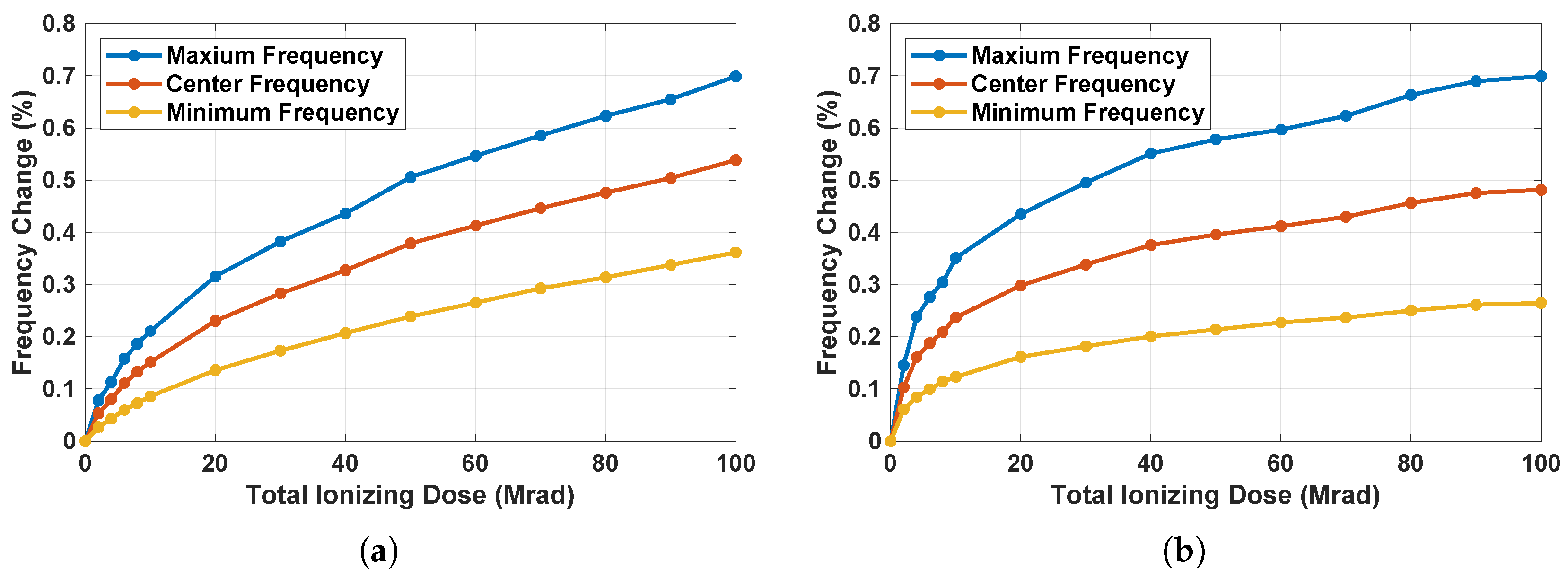

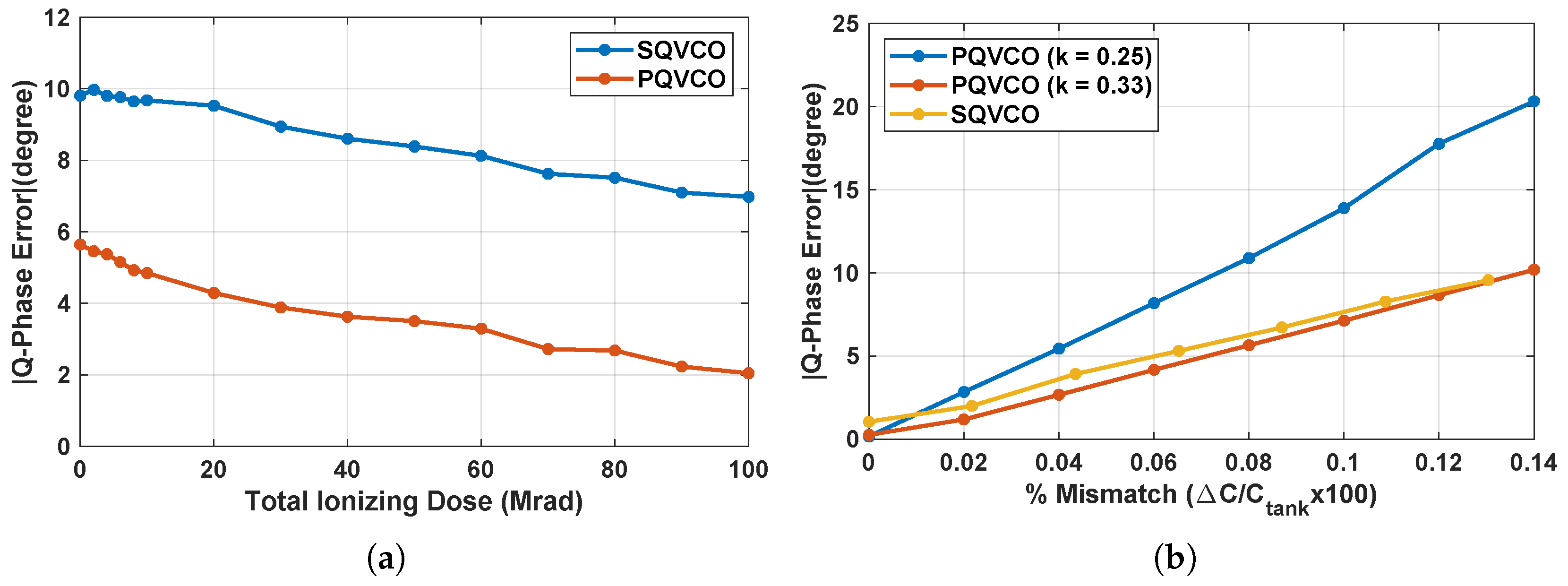

| Reference | TNS’17 [28] | TNS’18 [36] | TNS’18 [46] | TCASI’19 [47] | TNS’21 [29] | TNS’17 [33] | This Work | |
|---|---|---|---|---|---|---|---|---|
| Technology (nm) | 65 | 65 | 65 | 65 | 65 | 32 | 65 | |
| Type | VCO | VCO | VCO | VCO | VCO | QVCO | QVCO | QVCO |
| Oscillator Area (mm) | - | - | 0.124 | - | 0.061 | 0.0484 | 0.458 | 0.367 |
| Frequency (GHz) | 2.2–3.2 | 2.5–2.65 | 4.8–6.0 | 4.9–5.2 | 5.4–6.8 | 20.1–20.7 | 2.6–2.9 | 2.5–2.8 |
| Tuning Range (%) | 30 ** | 5.8 | 4 | 5.9 ** | 23 | 3 | 9.9 | |
| Phase Noise @1 MHz (dBc/Hz) | −110 | −118 | - | −122 | −100 | −99 | −119 | −115 |
| VCO Gain (MHz/V) | 240 ** | - | 1850 | 100 ** | 225 | 610 | 273 | 262 |
| Power (mW) | 6 | 1.8 | 18 | 34 | 2.85 | 12.8 | 13.2 | 13 |
| FoM (dBc/Hz) | −171 | −188.7 | - | −180 | −171.4 | −176 | −176.4 | −172.2 |
| Frequency Change (%) | 3.5 | - | - | 3.2 | 2.54 | 1.4 | 0.7 | |
| TID Tolerance | 600 | - | 250 | 350 | 1000 | 0.5 | 100 | |
Publisher’s Note: MDPI stays neutral with regard to jurisdictional claims in published maps and institutional affiliations. |
© 2022 by the authors. Licensee MDPI, Basel, Switzerland. This article is an open access article distributed under the terms and conditions of the Creative Commons Attribution (CC BY) license (https://creativecommons.org/licenses/by/4.0/).
Share and Cite
Karmakar, A.; De Smedt, V.; Leroux, P. TID Sensitivity Assessment of Quadrature LC-Tank VCOs Implemented in 65-nm CMOS Technology. Electronics 2022, 11, 1399. https://doi.org/10.3390/electronics11091399
Karmakar A, De Smedt V, Leroux P. TID Sensitivity Assessment of Quadrature LC-Tank VCOs Implemented in 65-nm CMOS Technology. Electronics. 2022; 11(9):1399. https://doi.org/10.3390/electronics11091399
Chicago/Turabian StyleKarmakar, Arijit, Valentijn De Smedt, and Paul Leroux. 2022. "TID Sensitivity Assessment of Quadrature LC-Tank VCOs Implemented in 65-nm CMOS Technology" Electronics 11, no. 9: 1399. https://doi.org/10.3390/electronics11091399





